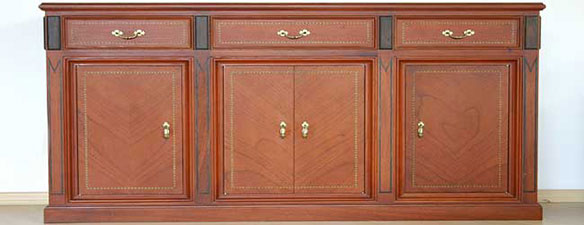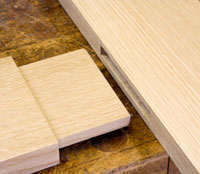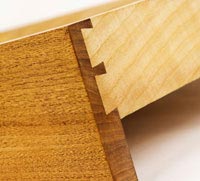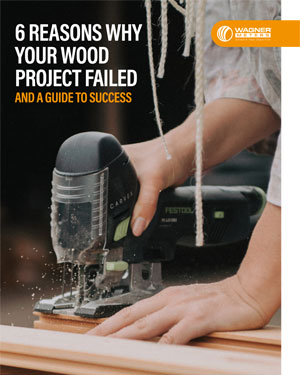Successful Wood Joints & Wood Moisture Content

Wood joinery exists to enable humans to link separate wood pieces together. Joinery is the heart of fine woodworking. Otherwise, the world would drown in the shavings of endless wood sculptures without the ability to connect pieces of wood! Engineers and woodworking project-makers alike can attest to the aesthetic and structural importance of strong and functional joints in every woodworking project.
Moisture resides in every wood species even after the kiln drying operation. When the moisture content (MC) exceeds acceptable parameters, the accompanying swelling and shrinkage of the wood can jeopardize a wood joint. Even if the joint is very small, its structural and performance integrity rests on a perfect fit. Therefore, it is wise to consider moisture meters for wood as a cost-saving moisture management tool for woodworking projects and the joints which build them.
Types of Wood Joints
Basic Butt Joint: where one piece of wood is butted against another and affixed with glue. The joint is usually strengthened by screws or nails. This is the weakest joint.
Mitered Butt Joint: similar to a butt joint, but both pieces have been beveled (usually at a 45-degree angle). This joint is often the most appropriate choice for square joints because the end grains of the two pieces of wood are hidden.
Lap Joint: one piece of wood overlaps another.
Tongue-and-Groove Joint: each piece has a groove cut all along one edge, and a thin, deep ridge (the tongue) on the opposite edge. If the tongue is unattached, it is considered a spline joint.
 Mortise and Tenon Joint: a stub (the tenon) will fit tightly into a hole cut for it (the mortise). The basic idea behind a mortise and tenon joint is that one piece of stock is inserted into the other, and then held in place with a fastener. Today, most woodworkers use glue to secure the tenon inside the mortise, but in years gone by, they would fashion the tenons so that they protruded through the mortised stock, to then be secured by a wedge or dowel.
Mortise and Tenon Joint: a stub (the tenon) will fit tightly into a hole cut for it (the mortise). The basic idea behind a mortise and tenon joint is that one piece of stock is inserted into the other, and then held in place with a fastener. Today, most woodworkers use glue to secure the tenon inside the mortise, but in years gone by, they would fashion the tenons so that they protruded through the mortised stock, to then be secured by a wedge or dowel.
Box joint: (also called a finger joint): several lap joints at the ends of two boards; it is used for the corners of boxes.
Finger joint or comb joint: A joint used as a way of conserving timber, as a means of joining random lengths of timber to be machined to a finished piece.

Dovetail joint: a form of box joint where the fingers are locked together by diagonal cuts.
Dado joint: a slot is cut across the grain in one piece for another piece to set into; shelves on a bookshelf having slots cut into the sides of the shelf, for example.
Groove joint: like the dado joint, except that the slot is cut with the grain.
Moisture Content in the Joint
Wood is an anisotropic material. An anisotropic material is a material which does not behave the same way in all directions. As an example, wood is very strong along the grain but against the grain, however, it will easily break. Many wood joinery techniques either depend upon or compensate for the fact that wood is anisotropic. This must be taken into account when joining wood parts together, otherwise the joint is destined to fail.
These anisotropic qualities are endemic to wood species, but they are triggered by changes to the wood’s MC. All wood loses or gains moisture in an attempt to reach a balance or equilibrium with the conditions of the surrounding air. This balance depends upon the relative humidity (RH) and temperature of the surrounding air and is the woods equilibrium moisture content (EMC). When RH falls, the wood shrinks and when RH rises, the wood expands.
In woodworking, it is even more critical, as heating and air conditioning can cause major changes in the MC of the wood. All woodworking joints must take these changes into account, and allow for the resulting movement.
Wood is stronger when stressed along the grain (longitudinally) than it is when stressed across the grain (radially and tangentially). When the wood’s MC changes, this can impact any wood joint, particularly when adhesives may be adding moisture to the equation. Some joinery methods count on expansion to form strong joints, but excess MC causes potentially-damaging wood dimensional changes. If the two wood pieces being joined have significantly different MC levels, then the final joint may be flawed.
The MC of wood is ever-changing as RH levels change in its surrounding environment. It always will, because RH perpetually influences MC. The key is to manage the wood’s MC to eliminate potential joint failures due to the natural expansion and contraction of wood.

Free Download – 6 Reasons Your Wood Project Failed
Why Measurement Helps
A wood moisture meter is a fail-safe way to measure the MC of the wood during all phases of the woodworking project to guarantee successful wood joints that do not fail. Modern technology has led to the development of pinless moisture meters for wood, which can quickly and easily measure the MC of the wood up to usually a ¾” depth.
Today’s wood moisture meter can provide a digital display of the MC of the wood, so woodworkers can determine if the MC falls within project specifications. Ideally, it is best to use moisture meters to measure each wood piece before creating a joint that will unite them. That way, woodworkers can take precautionary steps to control wood with excessive MC before it does any end product damage.
A wood moisture meter can help to ensure strong wood joints and durability for the wood product.
Larry Loffer is a senior technician at Wagner Meters, where he has over 30 years of experience in wood moisture measurement. With a degree in Computer Systems, Larry is involved in both hardware and software development of wood moisture measurement solutions.
Related Posts via Taxonomies
Last updated on May 4th, 2021




Hi Larry
We have had a problem with our kitchen as the joints keep expanding. The kitchen company came down with a moisture meter (not sure what make)
Which meter would you recommend for kitchen cabinet doors? If I purchased a meter from you is it likely to have the same readings or can they differ significantly?
We live in the UK near the sea, if the reading they took was 14% in the oak doors is this too high for the UK?
They informed us that with a 14% reading of moisture content the RH would be 75% does this appear to be correct with your equation?
I have read an article about the national standards in the UK that timber should have the following moisture content, which I am trying to use against the kitchen company. Have I got the correct information?
• 18% in covered, generally unheated spaces
• 15% in covered, generally heated spaces
• 12% in internal conditions: in continuously heated buildings
• 20% or more for external timber.’
Any information you provide would be most welcome!
Kind regards
Ian
Hi Ian,
Moisture readings will vary slightly from the different manufacturers. I would recommend the Wagner MMC220. It will measure all species of lumber even the exotic hardwoods from overseas and has a 7-year warranty. For more information, please click on this:
https://www.wagnermeters.com/shop/mmc220-extended-range-moisture-meter/
Wood will eventually equalize to its surroundings and expand or contract as conditions change. According to our free App “WoodH2O”, to achieve an equilibrium moisture content of 14% with a relative humidity level of 75%, the ambient temperature needs to be 84 degrees Fahrenheit.
I can’t comment on the National Standards in the UK but they seem reasonable.
Thank you,
Larry